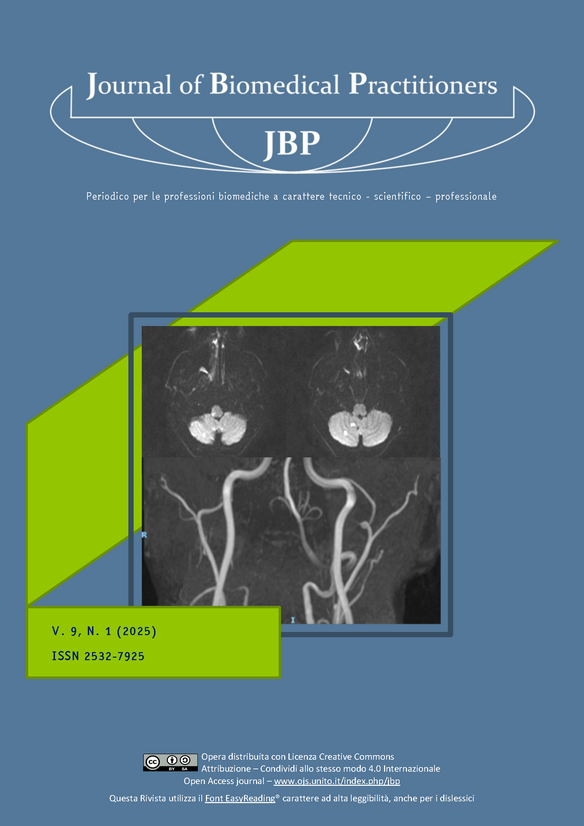Analisi dei rischi clinici in radiologia domiciliare attraverso il metodo FMEA.
Contenuto principale dell'articolo
Abstract
INTRODUZIONE
Il presente studio analizza i rischi di sicurezza legati alla radiologia domiciliare, un servizio in crescita a causa dell’aumento dell’età media e delle malattie croniche e sul quale i riferimenti in letteratura sono pressoché assenti.
MATERIALI E METODI
Attraverso un'analisi SWOT preliminare, sono stati individuati i punti di forza, debolezza, opportunità e minaccia del servizio. Tra i punti di forza emerge la possibilità di eseguire esami diagnostici direttamente a domicilio, riducendo disagi per pazienti con difficoltà di mobilità e migliorando l'accesso alle cure. Tra le debolezze spiccano la complessità organizzativa, la scarsa adozione di questo servizio da parte dei medici di medicina generale e la mancanza di personale dedicato. Le opportunità includono l’ampliamento del servizio e il soddisfacimento delle esigenze di una popolazione vulnerabile, mentre le minacce riguardano problematiche logistiche e di sicurezza dei dati. Successivamente è stata eseguita un’analisi dei potenziali errori utilizzando la metodologia proattiva FMEA.
RISULTATI
Sono state individuate 52 modalità di errore, principalmente riconducibili a criticità gestionali, tecniche e comunicative. Tra queste si segnalano l’errata identificazione del paziente, l’inadeguata valutazione dell’idoneità per un esame a domicilio e l’errata interpretazione delle immagini. Tali errori sono amplificati dalle condizioni ambientali e organizzative tipiche del contesto domiciliare, come la mancanza di sistemi automatizzati di identificazione del paziente e la presenza dei familiari e/o caregiver.
DISCUSSIONE E CONCLUSIONI
Nello studio sono state proposte delle azioni di miglioramento che includono una formazione continua e specifica per il personale sui rischi della sicurezza delle cure nel processo di radiologia domiciliare, la partecipazione attiva dei pazienti e familiari/caregiver e la semplificazione della procedura nella fase pre-indagine. È stato inoltre sottolineato il ruolo cruciale dei pazienti e dei familiari/caregiver al fine di poter garantire la sicurezza del processo diagnostico: la loro sensibilizzazione e il coinvolgimento attivo possono contribuire a ridurre gli errori e migliorare l’efficacia del servizio. Come evidenziato dall’Organizzazione Mondiale della Sanità già nel 2013, se i pazienti vengono informati sulle procedure, mediche e non, attraverso l’utilizzo di materiali chiari e comprensibili, come icone, immagini o diagrammi, si aumenta in loro la consapevolezza sui rischi associati all’esame che andranno a svolgere. In conclusione, lo scritto non solo contribuisce al tentativo di colmare una lacuna esistente, ma pone anche l’accento su una modalità di approccio proattivo al rischio clinico, portando, come principale risoluzione, il paziente al centro delle cure.
Downloads
Dettagli dell'articolo
Gli autori mantengono i diritti sulla loro opera e cedono alla rivista il diritto di prima pubblicazione dell'opera, contemporaneamente licenziata sotto una Licenza Creative Commons - Attribuzione che permette ad altri di condividere l'opera indicando la paternità intellettuale e la prima pubblicazione su questa rivista.
Riferimenti bibliografici
[1] ISTAT. Rapporto annuale sulla popolazione italiana. Roma: ISTAT; 2023. https://www.istat.it/storage/rapporto-annuale/2023/Rapporto-Annuale-2023.pdf
[2] Ministero della Salute. Piano Nazionale della Cronicità. Roma: Ministero della Salute; 2016. https://www.salute.gov.it
[3] PNRR. Piano Nazionale di Ripresa e Resilienza: Innovazione e sanità digitale. Roma: Ministero dell’Economia e delle Finanze; 2021. https://www.governo.it/sites/governo.it/files/PNRR.pdf
[4] Organizzazione Mondiale della Sanità. A health telematics policy in support of WHO’s Health-For-All strategy for global health development: report of the WHO group consultation on health telematics, 11–16 December, Geneva, 1997. Ginevra: WHO; 1997.
[5] Organizzazione Mondiale della Sanità. The Solid Facts – Home Care in Europe. Copenaghen: WHO Regional Office for Europe; 2008. https://www.euro.who.int/__data/assets/pdf_file/0005/96467/E91884.pdf
[6] Benvenuti M, Trentino A. La gestione del rischio clinico in radiologia: strategie e strumenti operativi. Milano: Springer; 2020.
[7] Smith J, Jones R. Failure Mode and Effects Analysis: A systematic approach to risk assessment in healthcare sys-tems. Berlino: Springer; 2020. https://doi.org/10.1007/s11010-013-2305-z
[8] Hill T, Westbrook R. SWOT analysis: It's time for a product recall. Long Range Plann. 1997;30(1):46–52. http://dx.doi.org/10.1016/S0024-6301(96)00095-7
[9] Vari autori. Donne. Salute. Territorio. Milano: Edra; 2023. https://www.protagoniste.it
[10] Ministero della Salute. La sicurezza dei pazienti e la gestione del rischio clinico: Glossario. Roma: Ministero della Salute; 2006. https://www.salute.gov.it
[11] Bowles JB. An assessment of RPN prioritization in a failure modes effects and criticality analysis. Risk Anal. 2004;24(1):13–24.
[12] Golfieri R, Pescarini L, Fileni A, Silverio R, Saccavini C, Visconti D, et al. Clinical Risk Management in radiology. Part I: general background and types of error and their prevention. Radiol Med. 2010;115(7):1121–46. https://doi.org/10.1007/s11547-010-0578-0
[13] International Commission on Radiological Protection (ICRP). The 2007 Recommendations of the International Commission on Radiological Protection. Ann ICRP. 2007;37(2–4). https://www.icrp.org/docs/icrp_publication_103-annals_of_the_icrp_37(2-4)-free_extract.pdf
[14] Agenzia Nazionale per i Servizi Sanitari Regionali (AGENAS). Guida cittadino uniti sicurezza: Il coinvolgimento dei pazienti nella sicurezza delle cure. Roma: AGENAS; 2023.
[15] Organizzazione Mondiale della Sanità. Exploring patient participation in reducing health-care-related safety risks. Int J Health Saf. 2013;10(1):101–10. https://www.who.int
[16] World Health Organization. Exploring patient participation in reducing health-care-related safety risks. Int J Health Saf. 2013;10(1):101–10. https://doi.org/10.1007/s11010-013-2305-z
[17] World Health Assembly, 72a sessione. Global action on patient safety. Ginevra: World Health Organization; 2019. https://iris.who.int/handle/10665/329284
[18] Commissione Salute – Coordinamento Rischio Clinico – Sicurezza alle Cure. Coinvolgimento dei pazienti, delle fa-miglie e della comunità nella promozione e nel miglioramento della sicurezza dalle cure. Roma: Ministero della Salute; 2023.
[19] Vincent C. Patient Safety. 2a ed. Oxford: Wiley-Blackwell; 2010.
[20] Ministero della Salute. Sicurezza dei pazienti e gestione del rischio clinico: Manuale per la formazione degli ope-ratori sanitari. Roma: Ministero della Salute; 2007. https://www.salute.gov.it
[21] Hollnagel E, Wears RL, Braithwaite J. Resilient Health Care. Farnham: Ashgate; 2015. https://pubmed.ncbi.nlm.nih.gov/26294709/
[22] Reason J. Managing the Risks of Organizational Accidents. Farnham: Ashgate; 1997. https://www.scirp.org/reference/referencespapers?referenceid=1716897

